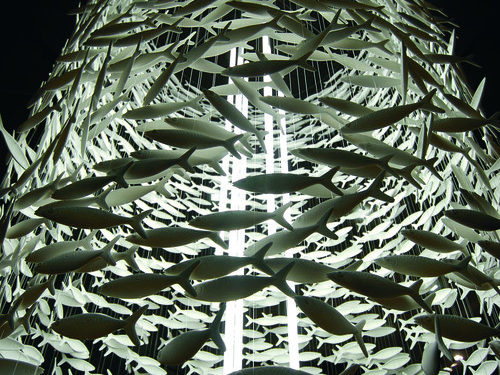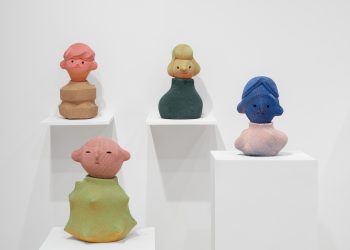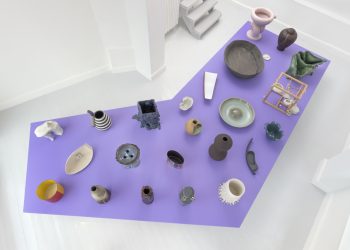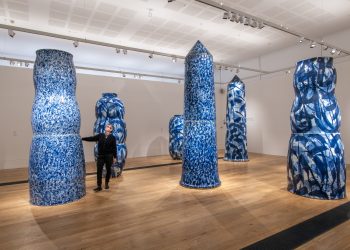Watt’s Up? Ceramics and Light / Bernardaud Foundation, Limoges, France
June 13 – November 29, 2014
Watt’s Up? explores the relationship between ceramics and light by presenting some thirty works of art from all over the world, all created in recent years. Oddly enough, this relationship seems to inspire artists more than designers, trained to create objects such as lamps. Perhaps that’s because light transcends objects and gives us a whole new take on the world. Light affects our vision by modifying our perception of space and movement. In addition, there is a symbolic, poetic and mysterious element to it. As the French author Jean Giono once put it, very clever mysteries hide in the light. If light and ceramics go hand in hand, it’s mainly courtesy of porcelain’s unique properties of translucency, which can give light – produced by a candle or a tungsten filament – a soft, poetic aura and elicit a feeling of wonder. Ceramics offers a broad palette of sensations to play with. Faience is heavy, glossy and sensual in its interaction with light. Pottery absorbs lux units and asserts its own material plasticity to counter the intangible nature of light. Porcelain is lightweight and translucent, and the matte aspect of unglazed biscuit forms a striking contrast with the gloss of the glaze. Watt’s Up? is an unprecedented investigation of the latest innovations and know-how, both sensorial and intellectual in scope.
As the topic was complex and broke new ground, it took nearly two years of research to bring these thirty or so works together. These works are by fifteen artists exhibiting for the first time in France. They are the result of technical prowess – manual and technical – as well as fresh creative thinking. None of them represent any particular school of thought, creative trend or artistic movement. Each work is an explosion of creativity, born of the artist’s reflections and inspiring a sense of wonder. This exhibition sheds new light on the art of ceramics.
Curated by Cédric Morisset
A double major in art history and cultural management, Cédric Morisset started out in contemporary art and gravitated towards design. He then moved into curating art shows, starting in 2003 at the invitation of the international design biennial in Lisbon and continuing in this line of work for several exhibitions presented in France and other countries, including French Reference (Shanghai and Canton, 2008), Icons of Design (Sao Paulo, 2009) and Nouvelle Vague (Milan, 2011 and 2013). Cédric Morisset contributes articles on design to AD magazine and the daily newspaper Le Figaro on a regular basis. From 2010 to 2012, he served as head curator for the annual AD Interieurs exhibition held by AD magazine. Since 2013, Cédric Morisset has headed the design department at the PIASA auction house in Paris.
Exhibiting artists

Frances & Dominic Bromley, Shoal 1672, 2008, Natural unglazed English fine bone china © Mark Wood Photography
Frances & Dominic Bromley
Since Frances & Dominic Bromley started their design studio Scabetti in 1999, their work in ceramics has earned considerable critical acclaim in the UK and across the world. Their designs are light, precise and elegant, and realised in fine bone china in their studio in Leek, North Staffordshire. Their first venture into light sculpture in 2004, was inspired by moths being attracted to candle light. Drawn to the Light, was composed of sculpted curved elements made out of bone china which appeared to be floating around the central light source. During London’s Design Festival in 2007, the couple presented Shoal, a suspended light sculpture suggesting a school of fish with more than 1500 bone china elements. These pieces paved the way for a series of bespoke commissions, which are now a Scabetti specialty. One commission for the International Maritime Organisation had 3,434 stylised bone china anchors arranged in a 5m tall sculpture and is on permanent display at their London Headquarters. Frances & Dominic Bromley have created Ascension especially for the Watt’s Up exhibition and their imagination has reached new heights. This new installation, made of English fine bone china, features hundreds of human forms that seem to be rising through the air towards the light. The creative talent of this design duo has added poetry to technical expertise.
Frances Bromley (b. 1969) and Dominic Bromley (b. 1971) majored in Industrial Design at Brunel University, London. They live and work in Leek, near Stoke-on-Trent, England.

Jeremy Cole, Cymbidium chandelier, 2012, Porcelain © Lindsay Keats
Jeremy Cole
The master artisan from New Zealand has been highly sought-after by the luxury sector since 2005. His remarkable porcelain lighting fixtures are inspired by the plant kingdom (e.g. flax, aloe vera, a chyrsalis or orchids). In his studio on the other side of the world, he creates beautifully crafted masterpieces that end up in Bulgari or Harry Winston show windows or at Four Seasons hotels. His unique lamps feature spectacular, poetic forms that imitate Nature; his magical lighting can make them look stylish, disturbing or amusing. And the porcelain orchids in his hanging lamp Cymbidium Orchid actually look dead until the light is turned on, making them come vibrantly alive.
Born in 1973 Jeremy Cole is a self-taught artists. He lives and works in Wellington, New Zealand.

Coup de foudre: Goedel Vermandere & Jan Arickx, La Vierge, 2010, Porcelain © Peter Verplancke
Coup de foudre: Goedel Vermandere & Jan Arickx
Goedel Vermandere used to teach school but became a ceramic artist in the mid 2000s. In 2004, she met an event planner named Jan and it was love at first sight… including at the professional level. As a design team, they went on to create light sculptures from cast porcelain that were remarkable for their sensuous quality and their harmony. The pair also works in steel, copper, stainless steel, paper and tree bark. They are always experimenting with new techniques to illuminate porcelain’s transparence more effectively, express a feeling of warmth and fulfillment, and open up new horizons.” Their creations – whether a hanging lamp forming a horizontal line in space, a standing lamp like a totem pole or a suspended lamp as round as a full moon – are striking for their simplicity and originality. One reason is that each of their pieces, which are fired gradually, starting at a low temperature and building up to 1260°C, is fashioned from hundreds of translucent porcelain petals and gives off a soft, romantic light. This talented twosome knows how to use technical skill to create poetry.
Goedel Vermandere (b. 1969) is a school teacher trained in ceramics at Syntra-West, Bruges. Jan Arickx (b. 1959) is an event planner. They live and work in Courtrai, Belgium.

Pucci de Rossi, Cartona, 2007, Porcelain © Made
Pucci de Rossi
Born in Verona, Italy, the artist and designer Pucci de Rossi moved to Paris in 1979. In step with the Memphis Art Movement, launched in Italy in 1981, he influenced the European art and design scene of the 1980s and 1990s. Throughout his career, he developed the wildly poetic side of his nature, not to mention his unbridled imagination. Constantly seeking to reinvent and reinterpret, he liked to use ordinary materials like lead or cardboard to create elegant, highly imaginative objects, and to turn preconceived ideas upside down. Poking fun at the “art or design” controversy, which is still raging, the artist gave everyday objects an ironic narrative treatment that rendered them precious. In the last decade, De Rossi exhibited at art galleries in Paris, such as Catberro, Downtown (François Laffanour) and Anne de Villepoix. Not only did his work impress collectors, but creations bearing his signature made their way into the collections of the Musée des Arts Décoratifs in Paris. His designs were produced by the editor Made who suggested In 2001 to release limited editions of his one-off objects. Among the latter were Dondola (rocking chair with book shelf, 2004) and his Cartona lamp (2005), which is presented in this exhibition and pays tribute – whether intentionally or not – to Arte Povera. Using fine porcelain to imitate humble cardboard, this creation flirts with contrasts and brings a little whimsy to everyday life.
Pucci de Rossi, 1947-2013

Bernadette Doolan, Nostalgia, 2008, Porcelain © Rory Nolan
Bernadette Doolan
For more than fifteen years, the Irish artist Bernadette Doolan has been creating works marked by their intimacy. She sets out to capture and express emotions in porcelain and bronze as well as in her paintings. “My work focuses on life, from the cradle to the grave and everything in between… on our dreams, desires and fears” she explains. The work presented in this show is an assemblage of illuminated box panels using engraved porcelain, which looks different depending on whether the lights are on or off. The artist is interested in our memories and in the motifs, landscapes and impressions stored in our subconscious. “I use objects that are meaningful in a personal way, such as the lace from a First Communion dress, to print on the porcelain surface,” comments Bernadette Doolan. “Sometimes, I even use plastic bubble-wrap, because I love the sound that the bubbles make when they pop!” When the panels are illuminated, the pattern communicates the emotions inherent in the private experience to the viewer.
Born in 1973 Bernadette Doolan is a self-taught artist. She lives and works in Wexford, Ireland.

Volker Haug, Rudolf, 2012, Porcelain © Paul Allister
Volker Haug
Based in Melbourne, Australia, the German-born designer Volker Haug designs one-off artisanal lighting creations. He got the idea for his clever Rudolf pendant from the double adaptors to be found on plastic lights in Berlin. The designer amused himself dreaming up all sorts of combinations. After a trip to Milan and a conversation with Ingo Maurer, a master of lighting design, Volker Haug returned to Australia determined to use porcelain for his Antler line. Rudolf revisits traditional chandelier design by assembling porcelain modules in every direction, combining industrial style with porcelain craftsmanship; modularity with unity. A rare example of a contemporary suspended pendant made from porcelain, it playfully suggests the antlers of Rudolf the Red-Nosed Reindeer.
Born in 1974 Volker Haug graduated from the University of Swinburne, Melbourne. Lives and works in Melbourne, Australia.

Cordula Kafka, Leaves, 2011, Porcelain © Cordula Kafka
Cordula Kafka
Working in her Berlin studio, the German designer Cordula Kafka specializes in incorporating light into porcelain objects for contemporary interiors. With a passion for her craft and for technical innovation, she is always trying to push the boundaries of her material. Her suspension lamp Leaves, presented in this show, takes porcelain to the limits of its thermal resistance. Extraordinarily thin layers of molded porcelain biscuit, textured like paper, create an impression of incredible lightness. The halogen lighting plays across a canopy of these leaves inserted into thin metal rods, accentuating porcelain’s whiteness while incandescent bulbs create a soft-focus atmosphere with yellow tones. The ceramic artist likes to establish this type of mood with pieces that include sleek, stark container candles that give the genre a new twist.
Born in 1966 Cordula Kafka graduated from Kunsthochschule Berlin, Ceramic Design and Art. Lives and works in Berlin, Germany.

Kenkichi Kurokawa, Stacking lamp, 1998, Porcelain © Kenkichi Kurokawa
Kenkichi Kurokawa
An associate professor at Kyoto Seika University’s Faculty of Design, Kenkichi Kurokawa has had a passion for ceramics since he was young. In 2002, the freelance ceramic designer set up a studio in which he creates light sculptures with distinctive lines, precise and straight. His pieces are assemblies of molded elements made from a porcelain paste known as Hanjiki, and is much appreciated by porcelain manufacturers for its whiteness and great resistance to torsional stress. The molded elements are fired in an electric kiln, then fitted together and wired for electricity. These minimalist sculptures, with their aura of purity and sensuality, have gained renown for the artist. The works of Kenkichi Kurokawa have been presented at more than twenty art exhibitions in Japan and feature in the collections of several Japanese museums.
Born in 1974, Kenkichi Kurokawa graduated from the University of Fine Arts and Music, Aichi Prefecture, and works in Kyoto, Japan.

Marre Moerel, Satirius, 2010, Earthenware © Pablo Orcajo
Marre Moerel
Born in the Netherlands, trained at London’s Royal College of Art, worked in New York and finally, set up a design studio in the heart of Madrid, Marre Moerel has developed products for established companies (e.g. Cappellini, Covo and Offecct) in various countries. Her work has appeared in many design exhibitions, including at the Victoria & Albert Museum and the Design Museum in London. The zoomorphic lamps in this exhibition are part of her Food on the Table collection of earthenware ceramic objects. The shape and function of each object, cast directly from animal organs (e.g. cow hearts, sheep brains and pig’s feet), derive from its natural form without further manipulation or “design.” Through this idea, the designer wishes to “confront us with the brutality and animal instincts which exist in all of us. At the same time, she shows us the beauty inherent in the rawness of nature, which we continue to be disconnected from, and which we can only hope to rediscover.”
Born in 1966, Marre Moerel graduated from Exeter College of Arts and the Royal College of Arts, UK. Lives and works in Madrid, Spain.

Sara Mouncer, Link up light, 2007, Porcelain © Joshua Pulman
Sara Mouncer
The stitches used in knitting served as the initial inspiration for the suspension lamp Link-Up-Light by UK artist Sara Mouncer. However, the final version is reminiscent of the wonderful glass suspension lamps created in Murano, Italy in the 1950s and ‘60s. She carved the first link by hand to achieve the undulating look of a woven thread. Sara then turned to create with molded elements, whose clean, sharp lines gave this decorative piece its precision and elegance. The suspension lamp can be configured to fit any space. It can be lit to enhance its sculptural qualities or to create a “chiaroscuro” effect, projecting mysterious shadows onto the walls. The porcelain interacts very effectively with light and dark to work its magic.
Born in 1964, Sara Mouncer graduated from the University of Brighton, UK, where she currently lives and works.

Margaret O’Rorke, Cloud Disks, 2012-2013, Porcelain © B. Ryberg
Margaret O’Rorke
During the past thirty years, the UK ceramic artist Margaret O’Rorke has created an exceptional body of work working with porcelain: her light sculptures. A leading ceramic artist, the author of Clay, Light and Water hand throws most of her creations in her Oxford studio. Her chandeliers, wall pieces and fountains bring poetry to technical complexity. The majority of her sculptures are thrown, reformed and firmed up with a blowtorch before joining and then fired in a complex process yielding delicate, translucent forms that are the fruit of her unique expertise. In this exhibition, several pieces demonstrate the artist’s talent and experience. Her Waves wall pieces, created during a workshop in Denmark, are inspired by the sight of breakers crashing on Baltic Sea shores. Circle of Light Cylinders, which dates to the 1990s, evokes the skyline of Osaka in Japan. In two spectacular creations – Wall of Cloud Discs and the suspended lamp Woven Light & Porcelain – co-created with Sirkka Paikkari, art weaver, she investigates the possibilities of light technologies, especially fiber optics, and the light-diffusing properties of porcelain, achieving a mysterious, lyrical effect like that of nocturnal bioluminescence.
Born in 1938, Margaret O’Rorke graduated from Chelsea School of Art and Camberwell School of Art Lives. She lives and works in Oxford.

Passage secret: Yaël Malignac & Guillaume Descoings, Le Rideau, 2013, Porcelain © Passage secret
Passage secret: Yaël Malignac & Guillaume Descoings
A graduate of the famous École Boulle, Yaël Malignac worked at the Lalique crystal company before joining the porcelain-making community in Limoges. That’s where she met a fellow modeler named Guillaume Descoings. Sharing a passion for ceramics, they became partners, personally and professionally. They create porcelain sculptures and functional objects at their Limoges workshop, casting pieces and firing them in an electric kiln. Among their more singular creations is Le Rideau (The Curtain). A very challenging project, that stands 3.2 m high and comprises 1,160 porcelain tiles in ten different thicknesses (0.9 mm to 4.4 mm) to vary the translucency. When lit, a pixellized decorative pattern is revealed. At once a luminous object and a screen, Le Rideau paves the way for new porcelain applications in interior design.
Yaël Malignac (b. 1978) graduated from École Boulle, France. Guillaume Descoings (b. 1975) graduated in ceramics modeling and technique in Vierzon, France. They live and work in Limoges, France.

Jeanne Quinn, You Are The Palace, You Are The Forest, 2009, Porcelain © Matthew Weedman
Jeanne Quinn
The work of American artist Jeanne Quinn always investigates dialectics: fragility and permanence, the real and the imagined, matter and energy, the natural and the artificial. All of these notions converge in her installation You Are The Palace, You Are The Forest, which also asks questions about how internal and external space meet or converge. “I imagine the space created by these forms as both outdoor and indoor, as at once a forest and a great hall,” says the artist. “The forest is a wilderness, an untamed place outside of our normal living space. It’s the space where the sages go to meditate; it allows for internal experience. The hall of chandeliers in palaces have become places we go to understand something about larger questions of history or culture. In this installation, I attempt to construct a space that allows for both kinds of awareness.” Designed during her stay as artist.in-residence at the EKWC, this installation using porcelain also represents an encounter between technology and craftsmanship. Starting with photographs of trees in Colorado, she proceeded to design several porcelain branches. First, she reproduced the trees in 3D form, created foam models and made molds. Then she cast the porcelain slip, to which she had added pigments to obtain graduated shades from white to grey. Once suspended, the branches create spatial perspective: the viewer gets the impression of entering a palace chamber or forest clearing. Subtle and full of poetry, this installation draws on nature, matter and light to create an otherworldly ambiance conducive to contemplation.
Born in 1966, Jeanne Quinn graduated from Oberlin College and the University of Washington. Lives and works in Boulder, Colorado, USA.

Kiki van Eijk, Soft table shade, 2009, Earthenware
Kiki van Eijk
Kiki van Eijk emerged on the effervescent Dutch design scene after graduating from the Design Academy Eindhoven in 2000. Her work, feminine in nature, infused with nostalgia and emotion, uses craft techniques that immediately set her apart from her peers, still heavily influenced by the trend in favor of hijacking objects and using zany humor introduced by Droog Design in the mid-1990s. Her whimsical mode of artistic expression has caught the eye of museums and galleries all over the world. Her creations include a rug sporting outsized flowers (Kiki Carpet), micro-architectures that look like curios from the family attic (Cut and Paste), earthenware furniture whose surface seems to be cushioned (Soft Cabinet) or giant teapots (Soft Teapot). Both of the lamps presented in this exhibition are from her Soft Series collection and feature an unusual trompe-l’œil effect: Soft Lamp looks as if it’s made of a soft, padded fabric whereas the contours of Floating Frame, a work that seems to hover in the air, blur the line between fact and fiction. The function of each object derives from the earthenware piece at the top. Pairing light with earthenware, the designer establishes a mood of lyrical intimacy that has become the hallmark of her art.
Born in 1978, Kiki van Eijk graduated from Design Academy Eindhoven. Lives and works in Eindhoven, the Netherlands.

David Wiseman, Botanical, 2009, Bronze and porcelain © Sherry Griffin for R & Company
David Wiseman
The American artist, represented by the R & Company gallery in New York, has always sought to capture and transpose the beauty of forms visible in the natural world (e.g. a tree covered with blossoms, a spider web or a glacier). For his Branch Chandeliers Series, he turned to trees – cherry, ginkgo, pomegranate, maple or magnolia – to select his motifs. “A few of my installations feature sculpted branches with buds and fruit that seem to emerge from the ceiling or wall… some even take over the whole space!” remarks the artist. “The challenge is to render the delicate, fleeting moment in which a tree bursts into flower.” David Wiseman’s creations have a strange magic all their own. Combining the fragility of porcelain and the strength of bronze, they capture, and give permanent expression to, the ephemeral nature of the living world. Their magic is intensified by the way the artist uses light to sharpen the contrast between the natural and the artificial in his work.
Born in 1981, David Wiseman graduated from Rhode Island School of Design. He lives and works in Los Angeles.
The Fondation d’entreprise Bernardaud
In 2002, Michel Bernardaud, chairman and CEO of the Bernardaud porcelain company, set up the Fondation d’entreprise Bernardaud, directed by Hélène Huret. Since then, its mission has been to draw attention to this marvelous material, whose qualities often go unrecognized. As part of its mission, the Fondation invites artists and designers of all nationalities and backgrounds to engage in creative give-and-take with house craftsmen, experiment boldly with porcelain and develop unexpected new applications outside the realm of fine tableware.
Bernardaud also holds a major contemporary art exhibition every summer. The purpose is to show visitors the rich and varied modes of expression used for ceramics all over the world. Since the Fondation was established, it has held innovative themed exhibitions, including the one devoted to white ceramic works (White Spirit in 2006), celadon (2003), centerpieces (2008) and ceramic jewelry (2010), some of which were subsequently presented at leading international institutions such as the Museum of Arts and Design (New York), the Musée des Arts Décoratifs (Paris), the Gardiner Museum (Toronto), the Yingge Museum (Taipei), the CODA Museum (Netherlands) and Sèvres-Cité de la céramique (Paris).
In 2014, the Fondation will be continuing its peregrination through the meanders of technical know-how, innovation and creativity by putting on a new and unprecedented exhibition devoted to the elective, symbolic and poetic affinities between light and ceramics.
CONTACT
Tel. +33 5 55 10 55 91
Bernardaud Foundation
27, avenue Albert Thomas
87000 Limoges
France
www.bernardaud.fr
More exhibitions / View the list of ceramic exhibitions worldwide



















